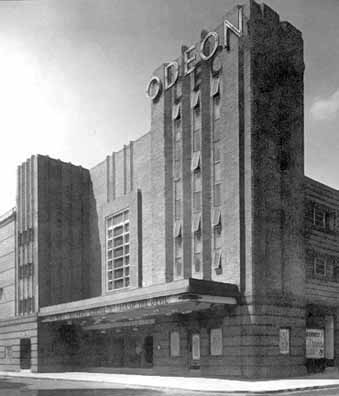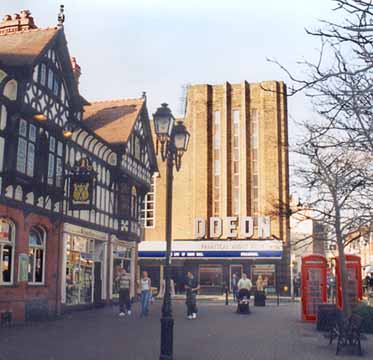The Odeon part I - on to part II
 The Art Deco Odeon, on the corner of Hunter Street and Northgate Street in Chester city centre, was designed by Robert Bullivant, who was part of a team of Birmingham-based architects headed by Harry Weedon (who designed no cimemas himself). It opened to an invited audience on 3rd October 1936. The Art Deco Odeon, on the corner of Hunter Street and Northgate Street in Chester city centre, was designed by Robert Bullivant, who was part of a team of Birmingham-based architects headed by Harry Weedon (who designed no cimemas himself). It opened to an invited audience on 3rd October 1936.
The practice was responsible for designing the majority of the Odeon cinemas throughout the country- they all have a similar look about them.
Many Odeons of the period, however, were faced with ceramic tiles, but a more fitting red brick was used here in Chester and also in York, which opened the year after Chester, 1937. The forms and materials employed at both Chester and York were deliberately restrained at the request of the planning authorities (under pressure from the Royal Fine Arts Commission) in order that the buildings respected their historic settings. Indeed, the authorities of both cities reluctantly gave permission for the buildings to be erected provided that they did not look like 'regular' Odeons.
The Odeon's interior was impressive, with the banded treatment of the ceiling and ribbed proscenium used to focus the eye towards the screen. A live orchestra pit was set below the screen. The room was also afforded decorative ventilation grilles, together with contemporary lighting features. The foyers were classically simple, with veneered panelling, rounded furniture and linear light features that resembled the ceiling fittings in the main auditorium.
The word Odeon means 'theatre' in Greek. The first of these- in fact, the first indoor theatre in the world, was built by Pericles on the south slope of the Acropolis in Athens in the mid 5th century BC. Recent research has shown that, due to the large number of columns utilised in its construction, around 40% of its 3,000-strong audience would have experienced difficulty in seeing very much of the action on stage!
The site had formerly been occupied by the imposing Northgate House, a private residence which was later used as offices and later still as lodgings for the judges at Chester Assizes.
The firm of P. Hamer Ltd of Swinton carried out the building work. Construction of the cinema was considerably delayed by an archaeological dig on the site, conducted by the great Professor Robert Newstead. Architect Robert Bullivant recalled "At Chester, the first evidence of Roman settlement was found at a level more than twenty-five feet below Northgate Street and survey of the drainage ducts cut by the Romans out of solid sandstone occupied Professor Newstead for over two months". The dig unearthed some interesting Roman and medieval remains, which were put on show in the upper lounge and remained until the cinema closed.
The opening of the Odeon was a glittering affair. People in attendance included: Mr and Mrs Oscar Deutsch, the founder of Odeon Cinemas, film star Douglas Fairbanks Junior, The Jack Payne Band, the Mayor of Chester and the architects.
Mr Deutche's District Manager at the time of the opening was G R Eley, known as Reg (thanks to his daughter Ann Eley for this).
Oscar Deutsch was the son of a Hungarian immigrant who had come to Britain at the end of the 19th century. He said that his aim in building up his chain of Odeons, his 'palaces for the people' which eventually grew to over 250 throughout the nation, was to repay the country that gave him and countless others protection during the era of Fascism and also to provide luxurious surroundings and good entertainment for working people. The word 'Odeon' became the acronym, 'Oscar Deutsch Entertains The Nation'.
 The film chosen to open this, Chester's second 'super cinema' (the first being the Gaumont in Brook Street) was Two's Company starring Gordon Harker and Ned Sparks. The second feature, The Harvester was shown from the following Monday. The film chosen to open this, Chester's second 'super cinema' (the first being the Gaumont in Brook Street) was Two's Company starring Gordon Harker and Ned Sparks. The second feature, The Harvester was shown from the following Monday.
The first person to manage the hall was Harry Yorke. He had come to Chester from the Odeon Brighton. British Thomson Houston from Rugby provided the projection equipment. Today Italian Cinemeccanica machines project the images. Full automation is another feature, which is present in most cinemas today.
Following Oscar Deutsch's death in 1941, Joseph Arthur Rank took the helm. Odeon merged with Gaumont cinemas in 1948, forming Circuits Management Association. The French company Cinvin now run Odeon cinemas.
For many years, whenever a British film was shown, the Union Jack would be flown at the.top of the building.
In 1976 the Odeon was converted to a three-screen cinema. A new projection suite provided projection for the three units. The newly ‘tripled’ cinema re-opened on 11th April 1976 showing Jungle Book in Screen 1, The Towering Inferno in Screen 2 and The Romantic Englishwoman in Screen 3.
In 1991 two more screens were added and the old projection area was re-opened to serve these. Number one still has the original proscenium, enabling films to be screened as they were before conversion took place. A new canopy, listing all the attractions was also fitted. The five units are equipped with stereo sound- number one with Dolby Digital.
The Odeon, now a Grade II listed building, underwent a controversial facelift in 2002 when the red signage was removed and replaced by blue. A large new sign was also placed on the canopy. These alterations had been initially refused by Chester City Council's planners but, when the owners threatened to close the cinema if the "vital" refurbishments were not allowed to proceeed- resulting in considerable public alarm and a lot of letters in the local press- the council were forced to compromise and allow the changes to go ahead. Compare the 'new look' below with this photograph of just a few years ago...
 The Odeon is Chester's only remaining city centre cinema and is now one of Chester's top buildings, listed as number 39 in the city council's 'Millennium Festival Trail 2000'. The Odeon is Chester's only remaining city centre cinema and is now one of Chester's top buildings, listed as number 39 in the city council's 'Millennium Festival Trail 2000'.
A night out at the Odeon, perhaps preceded by a stroll on the City Wall and a couple of drinks and a meal in one of the numerous fine nearby hostelries, to our mind knocked spots off visiting the windswept wasteland of the Sealand Road Multiplex or the cheerless mock-American mall at Cheshire Oaks. The Odeon provided an atmosphere that most modern multiplexes can only dream of.
Right: Sunshine and shadow in Chester's Market Square in March 2003: the Art Deco Odeon contrasts pleasingly with the city's more traditional 'black & white' buildings.
"I was born in Handbridge in 1948, and lived in Meadows Place. I left England for Canada in 1970.
Growing up in Chester left me with some wonderful memories. Every Saturday, with my pocket money in hand I would go to the Saturday matinee at the Odeon cinema.
I remember 'Join the Club' run by the cinema and, on the week of your birthday you received a card and free admission to the following Saturday's morning show!
The morning show always started with the reading of the names of children who were having a birthday that week. Then a sing song would follow with such hits as "I never felt more like singing the Blues" and "Behind the Green Door". The cinema even had its own theme song that started "We come along on a Saturday morning, greeting everybody with a smile!" The whole show cost thrupence". Karen: April 2001
The story of the Chester Odeon continues here. Alternavely, visit the Northgate chapters of our Chester Virtual Stroll to learn more about this fascinating part of the city- or go on to find out a little about Chester's only suburban cinema- the Park in Saltney... |

 The film chosen to open this, Chester's second 'super cinema' (the first being the
The film chosen to open this, Chester's second 'super cinema' (the first being the  The Odeon is Chester's only remaining city centre cinema and is now one of Chester's top buildings, listed as number 39 in the city council's 'Millennium Festival Trail 2000'.
The Odeon is Chester's only remaining city centre cinema and is now one of Chester's top buildings, listed as number 39 in the city council's 'Millennium Festival Trail 2000'.